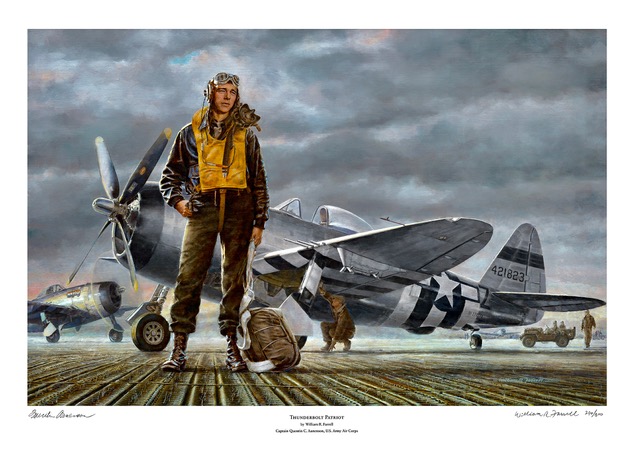“On May 13, 1999, I received a very interesting letter from a man I didn’t know, an artist who lives in New York City. His name is Bill Farrell, and the idea he described in his letter caught my immediate interest. He told me that for some time he had been working on sketches for a painting he wanted to do that would emphasize the pilot rather than the airplanes. I called him and we had an extended discussion about his objective. He asked me if I would agree to be involved as his technical consultant, and because of my enthusiasm for this project, I readily agreed. Fifteen months later this inspiring and emotional painting was completed.”
– Quentin Aanenson
“Even as a small boy I had wondered about the pilots who flew these beautiful but deadly fighting machines. Who were they? Where did they come from? What did it take to face an almost certain death in the daily ritual of war? How did we find such men?
Long before I began sketches for Thunderbolt Patriot I knew I wanted to create a portrait of a young warrior who had seen too much of war, wondering if he would survive his next mission. His weary expression would have to reflect a dedication and personal commitment that only a few understand.
It was important to me that this portrait show a fighter pilot, aged far beyond his years, silently standing alone. Are his thoughts of those he has saved — or the many lives he has taken? In this physically and emotionally drained young man, and all like him, there can only be questions, never answers.
After I had begun my rough drawings for an image I had long felt the need to create, I saw Quentin Aanenson’s powerful and poignant A Fighter Pilot’s Story on television, and I knew he would be the ideal representative for those who flew and fought for us — especially those who would never return.”
– William R. Farrell, New York City, August 6, 2000
Thunderbolt Patriot

He is young in years, but his face doesn’t show it. Fatigue is his constant companion. He has seen more than men should see; he has done more than men should do. He continues to function and do his job, almost as a reflex action.
He represents a generation of young warriors who have been assigned to fly the mighty Thunderbolt — the most powerful and deadly one man weapon of the war. He bears the burden of his assignment with stoic dedication.
The burning spirit of patriotism he brought to the war is no longer visible. Yet somewhere down within him the spark has not been extinguished. But now he fights not for any “grand cause,” but rather for his buddies in the squadron and the poor suffering foot soldiers on the ground, who count on him and his weapons to save them.
Most of his close friends are dead, so he protects his emotions by not making new friends. He has packed up too many footlockers, and sent too many “farewell letters” home to parents and wives. He cannot go through this again.
He lives, but his youth died 50 missions ago. He is haunted by the visions of past combat missions, as he has watched his friends burn to death or bail out and their chutes not open. He has become hardened; he no longer thinks of the Sixth Commandment, “Thou Shall Not Kill,” as he pulls the trigger on his machine guns.
He is running on empty — he has nothing more to give, but he knows he will be flying the first mission in the morning.
Home is an ethereal memory. Tomorrow is a fog. He deals only with today.
Who is this man of war? His name is his description.
He is the “Thunderbolt Patriot.”
For information regarding the purchase of signed and numbered limited edition prints of Thunderbolt Patriot, write or email the artist:
William R. Farrell
300 E. 33rd Street, Apt 7D
New York, NY 10016
